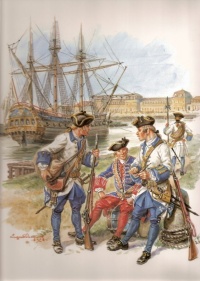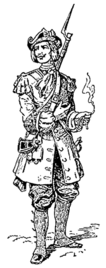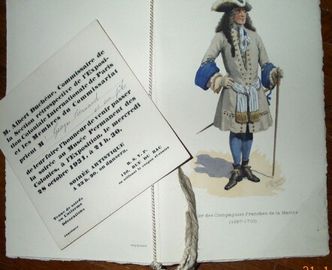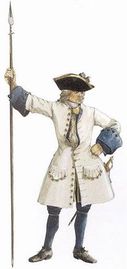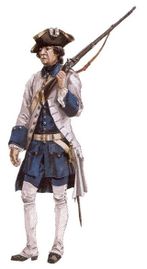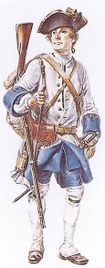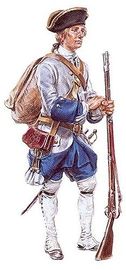Отдельные роты Морского министерства Франции
Материал из ВикиВоины
Отдельные роты Морского министерства Франции — вооруженные формирования Морского министерства Франции, сформированные специально для службы в Новой Франции — французской колонии в Северной Америке, на территории современной Канады.
История[править]
С 1670 по 1683 г. (в течении 13 лет) из метрополии (Франции) в Канаду не присылали никаких военных подкреплений. Лишь с 1683 г. туда стали направляться так называемые отдельные роты морского министерства (franches companies de la Marine). Эти войска иногда называют "морской пехотой", что не совсем верно, так как они состояли не из военных моряков, а из солдат, не имевших никакого отношения к флоту. Отличие "отдельных рот" от обычных сухопутных частей французской армии состояло только в том, что они находились в ведении морского министерства и использовались главным образом в колониях.
В середине и во второй половине 1680-х годов в Новую Францию регулярно прибывали новые "отдельные роты", и к началу Войны Аугсбургской лиги там насчитывалось в общей сложности около 1100 солдат и офицеров. Безусловно, в колонию попадали отнюдь не сливки французской армии. Служба в Америке была очень тяжелой, и немногим солдатам удавалось вернуться на Родину.
Со второй половины 1680-х годов в войсках морского министерства начали служить канадцы, так как для молодых представителей колониальной верхушки это был практически единственный способ сделать военную карьеру. В дальнейшем дислоцированные в Новой Франции "отдельные роты" превратились в своего рода "колониальные войска", так как подавляющее большинство офицерских должностей там было занято уроженцами колоний. Среди них эта служба была столь популярной, что губернаторы не раз обращались в Версаль с просьбой увеличить штат командиров, чтобы дать возможность всем желающим получить офицерский патент.
"Отдельные роты" составляли основу регулярных войск в Канаде вплоть до середины 1750-х годов (лишь в годы Семилетней войны в Америку были переброшены линейные части французских сухопутных сил). Постепенно они "канадизировались" и приспособились к местным условиям и способам ведения войны. Этому, безусловно, способствовало отмеченное выше преобладание уроженцев колонии среди офицерского корпуса, а также тот факт, что общее командование (опять-таки вплоть до Семилетней войны) осуществляли колониальные губернаторы или их помощники, т.е. люди, также хорошо знакомые с североамериканскими реалиями.
Униформа[править]
Clothing and equipment for the troops of New France were purchased in France and shipped out to Canada. Some of the clothing contracts and bills of lading have been preserved and provide considerable detailed information about the dress of colonial regulars. They also provide insight into the inevitable changes in details of dress and equipment that the Compagnies franches de la marine underwent during their seventy-five-year history.
In the 1750s, the private soldier was issued a long collarless single-breasted coat or justaucorps of greyish white, with lining and deep cuffs of blue. Pockets with horizontal flaps were set low on the hips, and the skirt corners could be hooked back to facilitate movement. The long-sleeved waistcoat, breeches, and stockings were blue.
A black felt tricorn, decorated with a cockade and button, was worn very low over the eyes; its brim was edged with false-gold lace. The buckled shoes were black. Gaiters of white duck, reaching just to the thigh, were fastened below the knee with a black strap. A white cravat and shirt completed the soldier's dress.
Corporals wore a yellow stripe of woollen lace around the top of the coat cuffs. Sergeants' uniforms were of similar pattern, but of better quality material; an inch-wide stripe of gold lace edged the cuffs and pocket flaps. Sergeant-majors wore two gold lace stripes on the cuffs and pocket flaps.
Drummers wore the King's small livery. The blue coat had brass buttons and red cuffs and lining. ft was heavily ornamented along the seams and buttonholes with the King's livery lace - white chain on a crimson ground. Waistcoat, breeches, and stockings were red. Otherwise the uniform was similar to that of the private soldier. The drummers' buff sword-belts and drum slings were bordered with livery lace. The blue drum shells were sprinkled with fleurs-de-lis.
Drum majors wore the King's great livery, which differed from that of the drummers only in the red triangles on white ground that appeared between the strips of livery lace.
Officers' uniforms were of the same pattern and colour as those of the men, but of better quality cloth. The waistcoat was frequently embellished with gold lace, but the coat was left unadorned. Buttons were gilt, and hats were braided with fine gold lace. Officers wore a gilt gorget on duty, and were armed with a gilt-hilted sword and an espontoon, which was exchanged for a fusil when in the field.
Cadets served in the ranks and wore the same uniform as the men; they were distinguished only by an aiguillette of blue and white silk with brass tips.
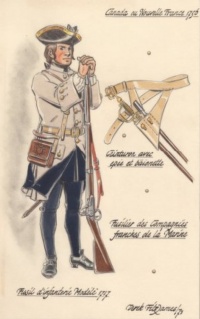
A buff leather waist-belt with brass buckles was attached to a double frog holding brown leather, brass-tipped scabbards for sword and bayonet. The brass-hilted sword had a straight blade. A red-brown leather cartridge-box was attached to the waist-belt; later, it was suspended on the right hip from a buff leather cross-belt. As descriptions of several patterns of cartridge-box have been found1 one can assume that this item went through a number of variations The standard French cartouchière of the mid-eighteenth century held thirty musket cartridges. The older cartridge pouch held only nine cartridges, and the flap was engraved with the King's arms or a white anchor and border. A small brass-mounted powder-horn completed the equipment.
On campaign or when stationed in western outposts, the colonial regulars adopted a casual, serviceable dress modeled on that of the woodsmen: buckskin or cloth leggings, moccasins, and breeches of Indian design In some cases, soldiers dressed entirely in the Indian fashion.
For winter dress, the Canadian hooded capot, woollen tuque and leggings, moccasins, and mittens were issued. The men moved across the deep drifts of the countryside on snowshoes.
While the precise designs of the muskets carried by the Cornpagnies franches de la marine have not survived, it is known that all were of the flintlock type, although many soldiers in Europe were still armed with matchlock muskets as late as the 1690s. As the colonial regulars were the responsibility of the navy, they carried navy-model muskets made at Tulle. In the 1740s, the navy began to purchase muskets from St-Etienne that probably resembled the army's 1728 model. By 1752, the royal magazines at Montreal and Quebec housed a considerable variety of muskets and bayonets. The French steel-mounted .69-calibre musket was somewhat lighter than the British Brown Bess.
The soldier of the Compagnies franches ire La marine in the illustration [above] is dressed for a summer campaign. He has discarded his heavy grey-white justaucorps, and wears his long-sleeved blue waistcoat as an outer garment. His buckskin mitasses (Indian leggings) and moccasins are better suited to the rough conditions than are shoes and white gaiters; the hatchet in his frog is much handier than a brass-hilted sword. A cloth fatigue cap has replaced the cocked hat.



